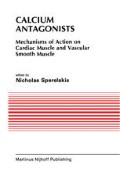Abstract
A large body of evidence suggests that the action of local anesthetics and antiarrhythmic drugs on membrane sodium channels is modulated by the state of the channel. That is, the affinity of the drug for its receptor varies and depends on whether the channel is rested and available, activated and open (conducting), or closed and inactivated (1–4) (see Fig. 1). The modulated receptor hypothesis for the action of sodium channel blockers has provided explanations for such phenomena as the selective depression of conduction in ischemic myocardium, suppression of tachycardias, and the selective action of lidocaine on ventricular vs. atrial tissue (4).
This work was supported in part by NIH grants HL-21672, HL-17452, and HL-29552
An established Investigator of the American Heart Association
Access this chapter
Tax calculation will be finalised at checkout
Purchases are for personal use only
Preview
Unable to display preview. Download preview PDF.
References
Hille B: Local anesthetics: Hydrophilic and hydrophobic pathways for the drug-receptor reaction. J Gen Physiol (69): 497–515, 1977.
Hondeghem LM, Katzung BG: Time- and voltage-dependent interactions of antiarrhythmic drugs with cardiac sodium channels. Biochim Biophys Acta (472): 373–398, 1977.
Hondeghem LM, Katzung BG: Test of a model of antiarrhythmic drug action. Effect of quinidine and lidocaine on myocardial conduction. Circulation (61): 1217–1224, 1980.
Hondeghem LM, Katzung BG: Antiarrhythmic agents: Modulated receptor mechanism of action of sodium and calcium channel blocking drugs. Annual Rev Pharmacol (in press), 1984.
Kawai C, Konishi T, Matsuyama E, Ohazaki H: Comparative effects of three calcium antagonists, diltiazem, verapamil, and nifedipine, on the sinoatrial and atrioventricular nodes. Experimental and clinical studies. Circulation (63): 1035–1042, 1981.
Trautwein W, Pelzer D, McDonald TF, Osterrieder W: AQA 39, a new bradycardic agent which blocks myocardial calcium (Ca) channels in a frequency- and voltage-dependent manner. Naunyn-Schmiedeberg’s Arch Pharmacol (317): 228–232, 1981.
Hescheler J, Pelzer, Trube G, Trautwein W: Does the organic calcium blocker D600 act from inside or outside the cardiac cell membrane? Pflugers Arch 393: 287–291, 1982.
Pelzer D, Trautwein W, McDonald TF: Calcium channel block and recovery from block in mammalian ventricular muscle treated with organic channel inhibitors. Pflugers Arch (394): 97–105, 1982.
Lee KS, Tsien RW: Mechanism of calcium channel blockade by verapamil, D600, diltiazem and nitrendipine in single dialysed heart cells. Nature (302): 790–794, 1983.
Kanaya S, Arlock P, Katzung BG, Hondeghem L: Diltiazem and verapamil preferentially block inactivated calcium channels. J Mol Cell Cardiol (15): 145–148, 1983.
Kass RS: Nisoldipine: a new, more selective calcium current blocker in cardiac Purkinje fibers. J Pharmacol Exp Therap (223): 446–456, 1982.
Colatsky TJ: Quinidine block of cardiac sodium channels is rate- and voltage-dependent. Biophys J (37): 343a, 1982.
Mason JW, Hondeghem LM, Katzung BG: Amiodarone blocks inactivated cardiac sodium channels. Pflugers Arch (396): 79–81, 1983.
Kass RS, Scheuer T: Slow inactivation of calcium channels in the cardiac Purkinje fiber. J Mol Cell Cardiol (14): 615–618, 1982.
Holck M, Thorens S, Haeusler G: Characterization of [3H]nifedipine binding sites in rabbit myocardium. Eur J Pharmacol 85: 305–315, 1982.
DePover A, Matlib MA, Lee SW, Dube GP, Grupp IL, Grupp G, Schwartz A: Specific binding of [3H]nitrendipine to membranes from coronary ar¬teries and heart in relation to pharmacological effects. Paradoxical stimulation by diltiazem. Biochem Biophys Res Comm (108): 110–117, 1982.
Godfraind T, Dieu D: The inhibition by flunarizine of the norepineph- rine-evoked contraction and calcium influx in rat aorta and mesenteric arteries. J Pharmacol Exp Therap (217): 510–515, 1981.
Jones AW: Vascular smooth muscle and alterations during hypertension. In: Bulbring E, Brading AF, Jones AW, Tomita T (eds) Smooth muscle: an assessment of current knowledge. University of Texas Press, Austin, 1981, pp 397–430.
Clusin WT, Bristow MR, Bain DS, Schroeder JS, Jaillon P, Brett P, Harrison DC: The effects of diltiazem and reduced serum calcium on is-chemic ventricular fibrillation in the dog. Circ Res (50): 518–526, 1982.
Weishaar RE, Bing RJ: The beneficial effect of a calcium channel blocker diltiazem, on the ischemic-reperfused heart. J Mol Cell ardiol (12): 993–1009, 1980.
Bush LR, Romson JL, Ash JL, Lucchesi BR: Effects of diltiazem on extent of ultimate myocardial injury resulting from temporary coronary artery occlusion in dogs. J Cardiovasc Pharmacol (4): 285–296, 1982.
Clusin WT, Bristow MR, Karagueuzian HS, Katzung BG, Schroeder JS: Do calcium-dependent ionic currents mediate ischemic ventricular fibrillation? Am J Cardiol (49): 606–612, 1982.
El-Sherif N, Lazzara R: Reentrant ventricular arrhythmias in the late myocardial infarction period. Effect of verapamil and D600 and the role of the “slow channel”. Circulation (60): 605–615, 1979.
Yamaguchi I, Obayashi K, Mandel WJ: Electrophysiological effects of verapamil. Cardivasc Res (12): 597–608, 1982.
Sheehan FH, Epstein SE: Effects of calcium channel blocking agents on reperfusion arrhythmias. Am Heart J (103): 973–977, 1982.
Author information
Authors and Affiliations
Editor information
Editors and Affiliations
Rights and permissions
Copyright information
© 1984 Martinus Nijhoff Publishing, Boston
About this chapter
Cite this chapter
Clarkson, C.W., Inazawa, M., Kanaya, S., Hondeghem, L.M., Katzung, B.G. (1984). Evidence for a Modulated Receptor Mechanism of Calcium Channel Blockade. In: Sperelakis, N., Caulfield, J.B. (eds) Calcium Antagonists. Developments in Cardiovascular Medicine, vol 39. Springer, Boston, MA. https://doi.org/10.1007/978-1-4613-3810-9_11
Download citation
DOI: https://doi.org/10.1007/978-1-4613-3810-9_11
Publisher Name: Springer, Boston, MA
Print ISBN: 978-1-4613-3812-3
Online ISBN: 978-1-4613-3810-9
eBook Packages: Springer Book Archive

